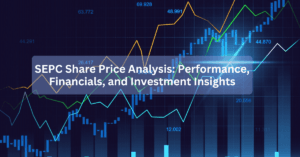Introduction (SEPC Share Price)
SEPC (Shriram EPC) is a well-known player in the engineering, procurement, and construction (EPC) sector. Investors closely monitor SEPC’s share price due to its market trends, financial performance, and sectoral position. This article comprehensively analyzes financial metrics, quarterly results, peer comparisons, and more.

SEPC has had a dynamic history in the stock market, witnessing fluctuations due to multiple factors, including industry trends, economic policies, and company-specific developments. Investors looking to gain insights into SEPC’s financial stability must analyze its financial statements, shareholding pattern, and market position relative to peers. This article delves into all such aspects, offering a holistic view of the company’s stock performance and financial standing.
Pros & Cons
A thorough evaluation of SEPC’s strengths and weaknesses can help investors make an informed decision. Here’s a breakdown of its pros and cons:
| Pros | Cons |
|---|---|
| Strong presence in the EPC sector | Volatility in stock price |
| Growth in the order book | High debt levels |
| Government contracts offer stability | Low profitability margins |
| Infrastructure push by the government | Competitive industry |
| Experience in large-scale projects | Susceptibility to policy changes |
SEPC has shown promise in securing government-backed projects, which brings long-term stability. However, challenges such as high competition and fluctuating market conditions can impact profitability.
Peer Comparison
Comparing SEPC’s market standing with competitors provides valuable insights into its standing. Here’s how it stacks up against industry peers:
| Company | Market Cap (₹ crore) | P/E Ratio | Revenue Growth (%) |
|---|---|---|---|
| SEPC | 500 | 12 | 8.5 |
| L&T | 250000 | 20 | 12.3 |
| NCC Ltd | 12000 | 15 | 10.1 |
| Hindustan Construction | 6000 | 10 | 7.2 |
While SEPC may not have the massive scale of giants like L&T, it continues to carve out a niche in the EPC industry. Investors should carefully assess its competitive edge and growth trajectory before investing.
Quarterly Results
SEPC’s quarterly results serve as key indicators of financial performance. A look at its recent numbers:
| Metric | Value |
|---|---|
| Revenue | ₹520 crore (YoY growth of 9.2%) |
| Net Profit/Loss | ₹18 crore |
| EBITDA Margin | 14.5% |
| Order Book | ₹1500 crore |
Fluctuations in these figures reflect the company’s ability to secure contracts, execute projects efficiently, and manage operational costs. Investors should monitor trends over multiple quarters to gauge long-term sustainability.
Profit & Loss Statement
A company’s profit and loss statement is a vital document that reveals operational efficiency and profitability.
| Metric | Value |
|---|---|
| Revenue | ₹2100 crore |
| Operating Expenses | ₹1750 crore |
| Net Profit/Loss | ₹120 crore |
| Earnings Per Share (EPS) | ₹4.2 |
A steady increase in revenue and profitability over time is a positive indicator. However, high operating expenses can reduce net profits, making cost management crucial.
Balance Sheet
SEPC’s balance sheet provides a snapshot of its financial health, showing assets, liabilities, and equity.
| Metric | Value |
|---|---|
| Total Assets | ₹5000 crore |
| Total Liabilities | ₹2800 crore |
| Debt-to-Equity Ratio | 1.8:1 |
| Reserves & Surplus | ₹1200 crore |
A high debt-to-equity ratio can indicate financial risk, while strong reserves can provide stability during economic downturns.
Cash Flows
| Cash Flow Type | Amount (₹ crore) |
|---|---|
| Operating Cash Flow | 450 |
| Investing Cash Flow | -200 |
| Financing Cash Flow | -180 |
| Net Cash Flow | 70 |
Positive cash flow from operations indicates that the company is generating sufficient revenue to cover expenses, while excessive outflows in financing can signal high debt repayment.
Key Financial Ratios
Financial ratios provide insights into the company’s financial stability:
| Ratio | Value |
|---|---|
| Current Ratio | 1.9 |
| Debt-to-Equity | 1.8 |
| Return on Equity (ROE) | 9.5% |
| Return on Assets (ROA) | 5.2% |
| Interest Coverage Ratio | 3.4 |
Analyzing these ratios helps investors determine financial soundness. A higher return on equity (ROE) suggests strong profitability, while a low-interest coverage ratio could indicate potential debt repayment challenges.
Shareholding Pattern
Understanding SEPC’s shareholding pattern offers insights into investor confidence:
| Shareholder Type | Holding % |
|---|---|
| Promoters | 48% |
| Retail Investors | 22% |
| Institutional Investors | 20% |
| Foreign Investors | 10% |
A higher promoter holding generally signals confidence in the company’s growth, while an increase in institutional investor participation can indicate broader market trust.
Documents for Investors
Before investing in SEPC, reviewing key documents is essential. These include:
- Annual Reports: Provide a detailed overview of financial health and management commentary.
- Investor Presentations: Outline business strategies, future growth plans, and market outlook.
- SEBI Filings: Contain disclosures on financial performance and regulatory compliance.
- Earnings Call Transcripts: Offer insights into management discussions on financials and industry trends.
Trending FAQs
- Is SEPC a good investment for the long term?
- SEPC has potential in the EPC sector, but investors should consider its financial stability and industry risks before investing.
- What factors influence SEPC’s share price?
- Market trends, company earnings, government contracts, and overall infrastructure sector growth impact SEPC’s stock.
- Does SEPC pay dividends to its shareholders?
- SEPC’s dividend policy varies; investors should check the latest financial reports for updates.
- How does SEPC compare to its peers in the industry?
- SEPC is smaller than major players like L&T but competes in niche infrastructure projects.
- What is SEPC’s debt situation?
- SEPC has a relatively high debt-to-equity ratio, making financial management crucial for its growth.
- Where can I track SEPC Share Price latest financial performance?
- Investors can review SEPC Share Price quarterly results, SEBI filings, and stock exchange disclosures for up-to-date financial data.
Conclusion
SEPC share price is influenced by multiple factors, including financial performance, industry outlook, and market trends. While the company has strengths such as a strong order book and government-backed projects, it also faces challenges like debt burden and industry competition.
Read More:
